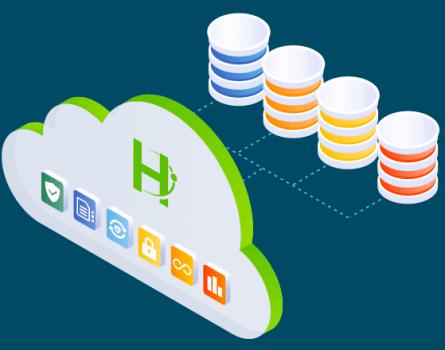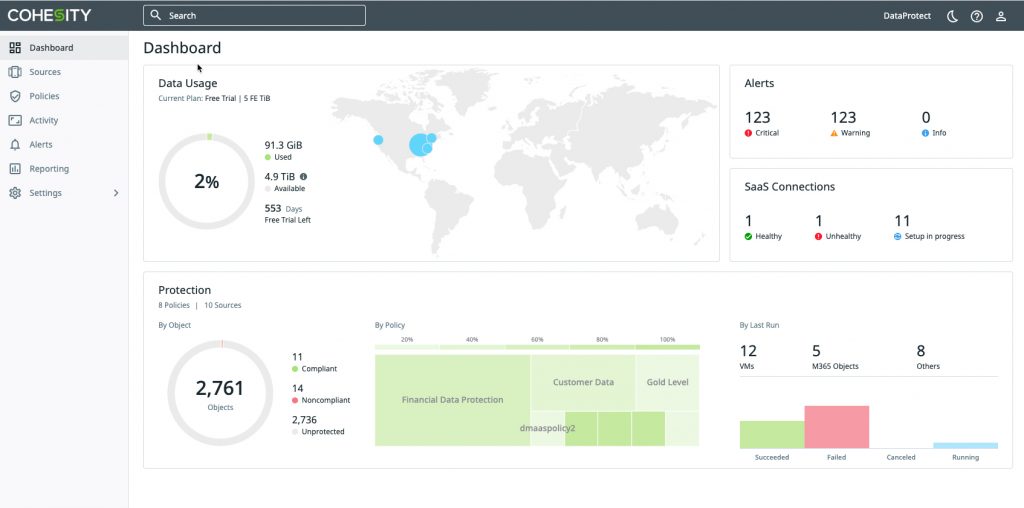Oracle is the leading provider of enterprise database solutions. It is the choice of most enterprises that see their need to scale out. Protecting a large-scale database is critical, but not easy. Oracle protects data with its efficient database backup and restore options. Oracle’s Backup and Recovery capabilities protects organizations against data loss due to hardware failures, data corruption, and catastrophic failures.
- Oracle’s Recovery Manager tool (RMAN) is integrated into Oracle and provides an extensive variety of backup and recovery capabilities that makes protecting your database easy in any environment. Oracle’s RMAN gives you the ability to restore your database to any desired point in time. Restoring a database to a determined point in time means you can recover all the relevant data right up to the point of corruption.
- Oracle’s RMAN shows its muscles when protecting large databases. Large multi-terabyte databases can take several hours to back up or restore. With RMAN you can divide the backup process into multiple tasks (channels) each with their own resources. You can significantly reduce the duration of long backups by spreading the backup task across several RMAN channels.
- Oracle’s Real Application Cluster (RAC) supports the need for high availability. With Oracle RAC a single Oracle database will run across two or more servers. In the event of a hardware failure, the Oracle database moves to a good server keeping the database up and running.
Oracle’s built-in data protection mechanisms are tried and true in organizations around the globe. The combination of Oracle configuration and the flexibility of RMAN to generate database backups are powerful tools to protect your data. But how to scale out? How do you meet the increasing complexity of orchestrating hundreds of backups and managing storage?
Learn more about how Cohesity’s modern backup and recovery solution for Oracle scales for data growth.
Trade Off Between Costs and Protection
Whichever backup and recovery solution you choose you’ll need to manage the competing goals between database backups and the cost of storage; between data protection and storage costs. Another factor in managing the balance between protection and costs is how to best use lower-cost cloud storage. How do you get your data up there, and more importantly, when you need it how do you get it back? Your data could be spread over both data center and cloud.
What is needed is a solution that enables you to both work the levers of database backups and control storage costs. Any Oracle DBA should be able to select and protect all their Oracle databases (on-premises and in the cloud) and efficiently manage storage from a single solution — without having to compromise between data availability and backups.
The combined problem of managing data protection at the same time as managing data cost, i.e. managing data cost as a function of data protection, is not easy. It means protection and cost go together with protection taking the upper hand.
You can only manage this way when you work the backup operations in concert with storage management. An example of this is a reservoir. There is only so much capacity to hold water. Some water is released from the gates at one end, while water is coming in from the river at the other end. Ideally you want to manage the reservoir’s capacity by controlling both the incoming water and water released by the gate.
In the same way, in protecting your Oracle data you manage the number of backups coming in with the capacity to store them, offset by those backups aging out.
Why is Database Protection So Challenging?
The real challenge is ensuring the complete protection of your data — backups, log backups, replication, and archival; while ensuring cost effectiveness — compression, deduplication, and retention.
Learn more about how Cohesity’s Unified Data Management for Oracle simplifies Data Management.
Managing Data Protection — Never Just “Set It and Forget It”
Managing data protection and data cost is never a “set it and forget it” proposition. It is not static, it is dynamic. Ensuring your data is protected requires constant vigilance against events that reduce the coverage of protection.
- Backup Job Blockers: The backup job itself can be interrupted for lots of reasons. For example, OS updates to the server, long-running data extractions that lock the database, instance failovers during the backup window, and network interruptions. These interruptions to the backup job require the attention of the DBA Team.
- SLA Violations: Backups can be interrupted when the backup task overruns the window of time allotted for its duration. For example: the database size can significantly change due to movement of historical data over to another table, data loading into the database, sudden growth, or creation of table indexes. These changes can significantly change the size of the database and the time it takes to back up.
- Addition of New Databases: new databases are created or migrated to the server. New databases need to be protected. Usually a full backup is taken after the database is online. The DBA must take care to protect the database but they must also follow through to ensure that replication and archiving of the data is successful.
- Not All Databases Are the Same: different types of databases require different backup strategies. You might have hundreds of databases, or a few large databases. Some of your databases might be highly transactional, and others only get updated once a month. Some of your databases require the highest level of protection including replication and archiving, other databases just need a single backup once a week. Your protection strategy is different for different classes of databases and over time your strategy is going to change. It is vital that you have an adaptable strategy for the different databases in your environment.
Cohesity’s Dashboard makes you effective in managing backups and storage at the same time.
Managing Data Cost — Never Just “Store It and Secure It”
Cloud storage, replication, and disaster recovery are now in the hands of the infrastructure team. Several reasons make managing data cost challenging:
- Legal Requirements for Data Retention: Take the case of patient medical records. Under HIPAA regulations, covered entities must retain electronic patient records for seven years. The length of time states require records to be retained varies from as short as five years to as long as ten. Backups and data costs must be managed for the long term otherwise data retention becomes a costly nightmare.
- DBA Team versus Infrastructure Team: Let’s be honest, in a perfect world the DBA Team and the Storage Team always work like a well-oiled machine. But in large organizations, these two teams don’t always communicate. These teams have competing goals. The DBA Team is responsible for ensuring the databases are protected, which consumes storage. On the other hand, the Storage Team is responsible for the efficient use of storage and its cost. And therein is the contest; the growing requirement for storage which backups demand, competes with the demand to conserve storage resources and minimize costs. Organizations must find tools to help manage the competing goals between data protection and data cost. Learn more about how Cohesity’s Single Solution can help.
- Moving to the Cloud and Back Again: In comes cloud storage with tiered storage lowering the cost of long-term storage—hallelujah. Moving backups and archives to tiered storage is a modern technological answer to alleviating the cost of storage. Getting data up into the cloud is easier than ever, especially with enterprise-grade backup as a service (BaaS) solutions. What is problematic is getting the data where it needs to be when you need it. For example, a two-terabyte backup file might take several hours to pull down from cloud storage. Once the download is complete, you might need to copy that file from where it landed over to the database server. Depending on the network’s bandwidth, that copy could be like pushing an elephant through a drinking straw — it’s going to take some time. Organizations need tools that efficiently move data to the cloud and back again, placing the data where it is required. Learn more about how Cohesity’s BaaS solution, DataProtect delivered as a Service can help.
In addition to protecting Oracle databases, Cohesity DataProtect delivered as Service protects other on-premises workloads like VMware and SQL Server as well as cloud and SaaS data sources like Amazon Web Services and Microsoft 365. Cohesity also addresses a wide range of data management use cases such as backup and recovery, disaster recovery, files and object services, and dev/test — all on a single platform and managed through a single UI —helping reduce complexity and eliminate mass data fragmentation.

















